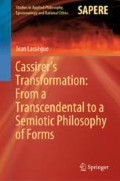Abstract
This chapter endeavors to examine the relationship between science, myth and their common semiotic foundation which has two aspects. The first one is shared by scientific and mythical thinking alike: it is the very existence of semiotic mediations such as linguistic signs and human institutions in general to conceal their role in the construction of reality, be it scientific or mythical. That is the reason why scientific and mythical thinking are being caught in the illusion that semiotic mediations can be disposed of and that reality can be grasped directly “as it is”. But scientific and mythical thinking strongly differ in their way of constructing reality through the concealed power of semiotic mediations: whereas scientific thinking builds a limited knowledge in specific domains expanding through history, mythical thinking keeps an all-encompassing viewpoint on reality that keeps it close to the very source of sense-making but does not develop through time. Philosophy appears therefore as a specific knowledge that takes distance from the illusion of the passive role played by semiotic mediations and reflects on their role in the construction of reality, be it mythical or scientific.
Access this chapter
Tax calculation will be finalised at checkout
Purchases are for personal use only
Notes
- 1.
The analogy is not complete however, since there is no intertranslatability of geometries the ones into the others. For example, it is possible to produce a Euclidean representation of the case of hyperbolic geometry in which there exists an infinity of parallels at a given point using Poincaré’s semi-plane, but this remains an exception rather than the rule.
- 2.
Cf. E. Cassirer, Axel Hägerström. Eine Studie zur Schwedischen Philosophie der Gegenwart, ECW 21, p. 87: “But even if it would be the case, only this particular starting point of the conceptions of law would therefore be described and this would not affect the whole of their possible “meanings”. Consequently, the constant transformation of this meaning and the motifs that become effective in it constitute the true problem. Hägertsröm repeatedly explains that already in the classical Roman jurisprudence the original mythical meaning had obscured the precise concepts of the law. He differentiates between a “original meaning” of the concept “jus”, “justum”, “injuria” and its “later meaning”. According to him, the original meaning of the concept “jus” is the supernatural force which is characterized by its purity from the stain of mortal germs, and which is also a mythical force of life.”
- 3.
E. Cassirer, The Philosophy of Symbolic Forms, vol. 1, p. 81 (ECW 11, pp. 10–11). Another example which Cassirer gives concerning this conflict is the way each symbolic form tends to make itself into an absolute within the cultural world; E. Cassirer, “Form and Technology”, in Ernst Cassirer on Form and Technology; Contemporary Readings, Hoel A.S. & Folkvord I. (eds.), Palgrave, Macmillan, 2012, p. 42 (ECW 17, p. 173): “Moreover, as technology unfolds, neither does it simply place itself next to other fundamental mental orientations nor does it order itself harmoniously and peacefully with them. Insofar as it differentiates itself from them, it both separates itself from them and positions itself against them. It insists not only on its own norm, but also threatens to posit this norm as an absolute and to force it upon the other spheres.”
- 4.
The case of logic in which it is possible, using a theorem of impossibility resting upon proof by contradiction, to delimit from within a specific conceptual domain also belongs to this type.
- 5.
Cf. Chapter 1, Conclusion.
- 6.
E. Cassirer, The Philosophy of Symbolic Forms, vol. 2, p. 26 (ECW 12, p. 33): “In knowledge, too, the use of hypotheses and principles precedes the knowledge of their specific function as principles—and until this insight is gained, science can only contemplate and state its own principles in a material, that is, semimythical form.”
- 7.
E. Cassirer, The Philosophy of Symbolic Forms, vol. 2, p. (ECW 12, p. 33): “For what distinguishes science from the other forms of cultural life is not that it requires no mediation of signs and symbols and confronts the unveiled truth of “things in themselves” but that, differently and more profoundly than is possible for the other forms, it knows that the symbols it employs are symbols and comprehends them as such.”
- 8.
Cf. Chap. 2, § 11.
- 9.
Cf. Chap. 1, § 13.
Author information
Authors and Affiliations
Rights and permissions
Copyright information
© 2020 Springer Nature Switzerland AG
About this chapter
Cite this chapter
Lassègue, J. (2020). The Semiotic Situation of Cassirer. In: Cassirer’s Transformation: From a Transcendental to a Semiotic Philosophy of Forms. Studies in Applied Philosophy, Epistemology and Rational Ethics, vol 55. Springer, Cham. https://doi.org/10.1007/978-3-030-42905-8_3
Download citation
DOI: https://doi.org/10.1007/978-3-030-42905-8_3
Published:
Publisher Name: Springer, Cham
Print ISBN: 978-3-030-42904-1
Online ISBN: 978-3-030-42905-8
eBook Packages: Religion and PhilosophyPhilosophy and Religion (R0)

